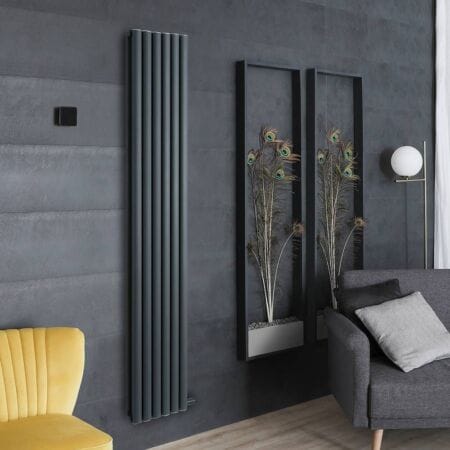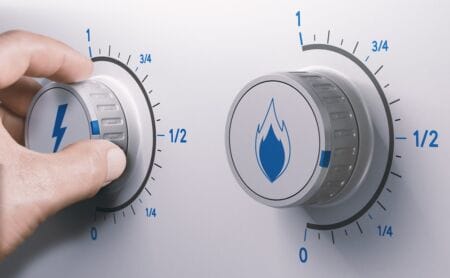Contents
ToggleWhat we'll cover...
All the elements that combine to create a sustainable heating system for lower emissions.
Key insights into sustainable heating solutions
In 2025, heating your home isn’t just about keeping warm anymore. It’s about doing so in a smarter, cleaner, way, and with long-term sustainability in mind. That means thinking beyond gas-guzzling boilers, clunky controls, and radiators that were probably fitted when dial-up internet was still a thing for sustainable heating.
Today, a sustainable heating system is one that delivers reliable comfort without racking up monster energy bills or harming the environment. But how do you know what makes a heating system truly sustainable? Is it about using renewable energy? Cutting carbon emissions? Reducing waste?
The answer is yes to each of the aforementioned.
Whether you’re renovating, replacing, or just researching, this guide breaks down exactly what makes a heating system sustainable and what practical steps you can take to build a sustainable heating system for your own home.
1. It minimises carbon emissions (without freezing you out)
A sustainable heating system prioritises low carbon output – either by using energy more efficiently or by switching to lower-carbon or renewable sources entirely.
The fossil fuel factor:
Most homes in the UK still rely on gas boilers, which burn natural gas – a fossil fuel that releases carbon dioxide. The more you burn, the bigger your carbon footprint.
Sustainable alternatives:
- Air source heat pumps – Absorb warmth from outdoor air and use electricity to transfer it into your home. Highly efficient, especially in well-insulated properties. Learn more in our ultimate guide to air source heat pumps.
- Ground source heat pumps – Extract warmth from underground. More expensive upfront but work incredibly efficiently in the long run.
- Electric heating (Lot 20-compliant) – When powered by renewables (e.g. green energy tariffs or home solar), Lot 20 approved versions of electric heating models become virtually carbon-free.
- Infrared heating panels – Efficient and clean, infrared heaters warm objects and people directly rather than the surrounding air.
With Lot 20 compliance, our electric radiators are ideal for households looking to reduce carbon emissions without a full system overhaul. Pair with a green electricity supplier and you’re heating with minimal carbon cost.
2. It's incredibly energy efficient
Sustainable heating isn’t just about what kind of energy you use – it’s about how little of it you need to stay warm. A good system should give you the comfort you want without wasting heat or power.
Features of an energy-efficient system:
- Smart controls (scheduling, zoning, learning thermostats)
- Adaptive start (pre-heating rooms at the most efficient time)
- Open window detection
- Fast heat-up and slow cool-down (like with dry thermal radiators)
- Modulating operation (instead of simple on/off cycling)
Look for:
- Lot 20 certification (for electric heating) – a legal requirement for newer electric heaters sold in the UK and EU that mandates built-in energy-saving features.
- ERP A+ or higher ratings (for boilers or integrated systems)
Our electric heating range is packed with energy efficient radiator options – from dry thermal electric radiators to ceramic core heaters with programmable smart timers. And you can learn all about their benefits in our complete guide to sustainable home heating as well.
Even the most sustainable heating system in the world is utterly pointless if your home leaks heat like a sieve. A truly sustainable setup relies on a properly insulated building fabric – so you’re heating your space, not the whole street for the benefit of the neighbour you can’t stand.
Insulation essentials:
- Roof/loft insulation – Stops rising heat from escaping through the ceiling.
- Wall insulation – Prevents warmth from bleeding out through brickwork.
- Floor insulation – Great for downstairs rooms or period homes.
- Draught-proofing – Small gaps around windows, doors and floorboards can cause big losses.
- Double/triple glazing – Retains indoor heat while reducing condensation and external noise.
BestHeating tip: Before spending thousands on a shiny new heating system, seal the gaps. Insulation isn’t glamorous, but it is ridiculously effective.
4. It's controlled intelligently, not constantly
Smart heating controls don’t just make life more convenient – they make heating measurably more efficient too. A truly sustainable system adapts to your routine, avoids waste, and responds to your behaviour in real time.
Features that make the difference:
- Zonal heating control – Warm up the rooms you need only, when you need them to be heated.
- Daily and weekly scheduling – Tailor your heating to your typical routine on a daily and weekly basis.
- Geofencing – Uses your phone’s location to switch the heating off when you leave the house and back on as you return.
- Weather compensation – Regulates heat output based on outdoor temperatures.
- Voice control or app access – Easily make tweaks from bed, the office, or the beach with simple voice commands.
Many of our electric radiators and smart control kits offer integrated digital programming, so you’re not constantly fiddling with dials – and wasting energy while you do it.
5. It can integrate with renewable technology
Sustainability isn’t just about using less – it’s about where your energy comes from. A future-ready heating system can integrate with:
- Solar PV panels
- Battery storage
- Smart grid tech
- Dynamic energy tariffs (charging less during off-peak hours)
Benefits of renewable integration:
- Lower running costs
- Ultra-low carbon output (especially with solar)
- Grid independence during peak times
- Compatibility with energy-export schemes
BestHeating tip: Our electric radiators are 100% compatible with solar PV setups and battery storage systems – ideal for those looking to fully embrace the low-carbon lifestyle.
6. It's designed for durability and circularity
Sustainability isn’t just about use – it’s about lifespan and end-of-life as well. The more durable and repairable a heating product is, the less it contributes to landfill and manufacturing waste.
Sustainable design traits:
- High-grade, recyclable materials (e.g., aluminium, steel)
- Easily replaceable parts (e.g., thermostats, elements)
- Long warranties and repair support
- Minimal plastic and packaging waste
We only supply heating products that meet our standards for durability, efficiency, and low maintenance. This results in longer life, less waste, and better performance for years to come. Our sustainable heating products are all Lot 20-compliant in turn.
7. It saves you money in the long run
Let’s be honest – people are more likely to go green when it helps them save a bit of green. And the good news is that sustainable heating systems are built to be cost-effective over time, even if the initial outlay is higher.
How you save:
- Lower running costs thanks to energy efficiency
- Less wear and tear = lower maintenance
- Eligible for government schemes (in some cases)
- Boosts EPC rating = more appealing to buyers/landlords
BestHeating tip: Upgrading to a more sustainable system – especially when switching from old gas or storage heaters – can lead to long-term savings of hundreds of pounds per year.
Start your sustainability journey with BestHeating
Building a sustainable heating system doesn’t have to be all or nothing. You don’t need to rip out your entire setup and go off-grid tomorrow. It’s about making smart, progressive upgrades. Improving efficiency here, cutting carbon there, and gradually building a system that’s better for your home and the planet.
Start small:
- Replace old or outdated radiators with Lot 20-compliant electric models.
- Add smart heating controls to your existing system.
- Improve insulation to reduce energy demand.
And then build from there.
Every little improvement counts. And BestHeating is here to help you make the next one. Let us know which sustainable heating upgrades you opt for in the comments section below, or via Instagram, Facebook or X.
John is a Research Specialist for the Best Heating Advice Centre, where for over nine years he has dedicated himself to demystifying home heating for our customers. He specialises in creating clear, data-driven guides and how-to articles by collaborating directly with our team of certified heating experts and product engineers.
His work, built on a foundation of journalistic research, has helped millions of readers make confident and informed decisions about their home heating. When he’s not breaking down the heat output differentials from radiators to heated towel rails, John fancies himself as a fine football and music connoisseur.








